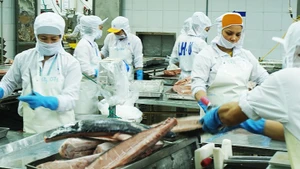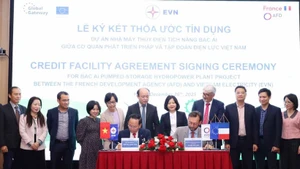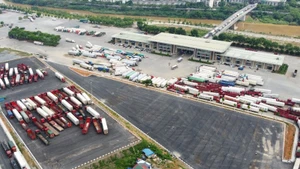Fruits from investment in processing
Do not advocate mass production and export, since its inception, Vinh Hiep Co., Ltd. has advocated associating with farmers to produce clean coffee raw materials, from which making bold investment in processing to produce high quality coffee products serving the domestic market and for exports.
Up to now, at Vinh Hiep coffee farms in Gia Lai province, thousands of original coffee seedlings have been planted to "measure" adaptation to climate change, and then supply coffee to the market. The company also signs product off-take contracts with farmers to ensure the output for their products and also help Vinh Hiep have a quality supply for production. Thai Nhu Hiep, General Director of Vinh Hiep Co., Ltd. said that thanks to the policy, Vinh Hiep has established an organic coffee brand named L'amant (the lover) with a chain of stores in Ho Chi Minh City. Vinh Hiep's coffee products have been recognised as an organic product by the United States and allowed to export to the US, opening up opportunities for Vietnamese coffee beans to expand around the world.
The story from Vinh Hiep is just one among many surrounding the success of the coffee businesses in investing heavily in processing. Luong Van Tu, Chairman of the Vietnam Coffee - Cocoa Association (VICOFA), said that over the past years, the amount of processing, roasted and ground coffee exporting to the world has been increasing. In the domestic market, Vinacafe, Trung Nguyen and Nestlé are the enterprises with the largest market share of instant coffee. At the end of 2018, Tin Nghia Coffee Company put another instant coffee production line with a capacity of 10,000 tonnes a year into operation in Dong Nai province, raising the country’s capacity in processing instant coffee even higher.
“Although in 2018, the volume of processed coffee accounted for just over 7%, but the value was very high,” Tu informed. Currently, Vietnam has been active in mastering the technology of roasting, sorting and polishing coffee. Even small coffee shops can buy their own locally produced roasters with a capacity of 5-15 kg per batch with attractive prices. In the future, investing in processing technology is expected to help increase the proportion of processed coffee to 25% of the country's total coffee output. In the next 10-15 years, the value of Vietnam's coffee market is predicted to increase from US$3.5 billion to US$6 billion.
According to the Ministry of Industry and Trade, coffee is an important commodity for Vietnam’s exports, accounting for 3% of the country's GDP. In recent years, although the world’s economy has suffered a range of difficulties, leading to reduced purchasing power, Vietnam's coffee exports still maintain an encouraging growth rate, reaching 8.2% per year with an average turnover of US$3.13 billion a year in the 2011-2018 period, accounting for 15% of the country's total agricultural exports.
Currently, Vietnamese roasted and soluble coffee exports have accounted for 9.1% of the world market share, ranked fifth after Brazil, Indonesia, Malaysia and India, creating opportunities and prospects for the coffee industry when Vietnam penetrates deeper into international markets through multiple signed free trade agreements.
Since the mid-90s of last century, post-harvest processing activities have been invested by Vietnamese enterprises. As a result, from the coffee price at the port of Vietnam at US$400-500 lower than the reference price at the London Commodity Exchange, Vietnam has gradually closed this gap and until now, the price of Vietnam's Robusta coffee has been in line with the world market prices.
To date, there are 97 coffee processing facilities, 160 roasted coffee processing establishments, eight instant coffee processing units and 11 blended coffee processing facilities across the country. Trung Nguyen's powder coffee and Vinacafe's instant coffee not only dominate the domestic market but are also welcomed in many regional markets, while helping the building of a Vietnamese coffee brand. The investment in intensive processing has helped the coffee industry to increase its competitiveness in the context of a sharp decline in exports in recent months, with coffee exports in the first nine months of 2019 estimated at 1.25 million tonnes worth US$2.15 billion, down 13.3% in volume and 21.9% in value over the same period in 2018.
Improving export efficiency
In order to achieve the goal of coffee export turnover reaching US$6 billion by 2030, while increasing the added value for Vietnamese coffee products, according to the Ministry of Industry and Trade, the coffee industry needs to be invested synchronously with effective overall solutions.
Accordingly, it is necessary to promote the effective restructuring of the coffee industry, establishing concentrated and specialised cultivation areas associated with the development of processing industry, applying hi-tech and promoting linkages between raw material areas and intensive processing establishments and factories to create sources of materials that are stable in both quality and quantity, meeting market requirements.
In parallel with the improvement of product quality, more attention should be paid on the branding building, in which businesses are mainly responsible for building their own brands. They are suggested to survey the market needs in the fields of market share - tastes - quality - price, thereby determining the suitable proportion for processing products (how many percentage for primary and refined products) to orient their product development strategies, as well as building appropriate marketing and branding plans suitable to their capabilities.
Regarding trade promotion, Vietnamese coffee exporters are urged to focus on recruiting and training staff with foreign language ability and professional qualifications, while actively participating in trade promotion programmes and activities organised by the relevant ministries, agencies and associations, as well as attending international fairs and exhibitions both at home and abroad to introduce their products and seek partners.
Tu added that Vietnam now has many coffee brands that have been well-known by international consumers, such as Vinacafe and Trung Nguyen, not to mention more and more young coffee businesses have been established to take advantages of the signed free trade agreements. They are making good use of modern trading trends, e-commerce and intensive processing technologies. This is the strength of Vietnamese coffee business to boost the sector’s development in a more sustainable manner in the future, Tu affirmed.
















